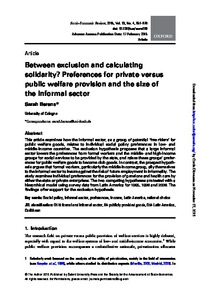Between exclusion and calculating solidarity? Preferences for private versus public welfare provision and the size of the informal sector

2015
13
4
Oct.
651-678
informal economy ; social policy ; social service
Economic development
http://dx.doi.org/10.1093/ser/mwu039
English
Bibliogr.
"This article examines how the informal sector, as a group of potential ‘free riders' for public welfare goods, relates to individual social policy preferences in low- and middle-income countries. The exclusion hypothesis proposes that a large informal sector lowers the preferences from formal workers and the middle- and high-income groups for social services to be provided by the state, and raises these groups' preferences for public welfare goods to become club goods. In contrast, the prospect hypothesis argues that formal workers, particularly the middle-income group, ally themselves to the informal sector to insure against the risk of future employment in informality. The study examines individual preferences for the provision of pensions and health care by either the state or private enterprises. The two competing hypotheses are tested with a hierarchical model using survey data from Latin America for 1995, 1998 and 2008. The findings offer support for the exclusion hypothesis."
Digital
The ETUI is co-funded by the European Union. Views and opinions expressed are however those of the author(s) only and do not necessarily reflect those of the European Union or the ETUI.